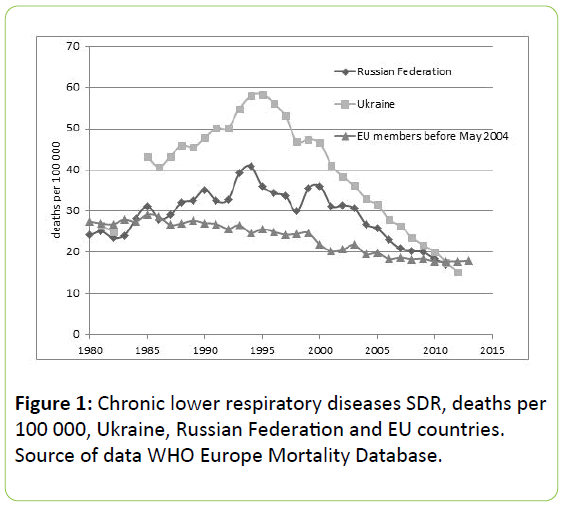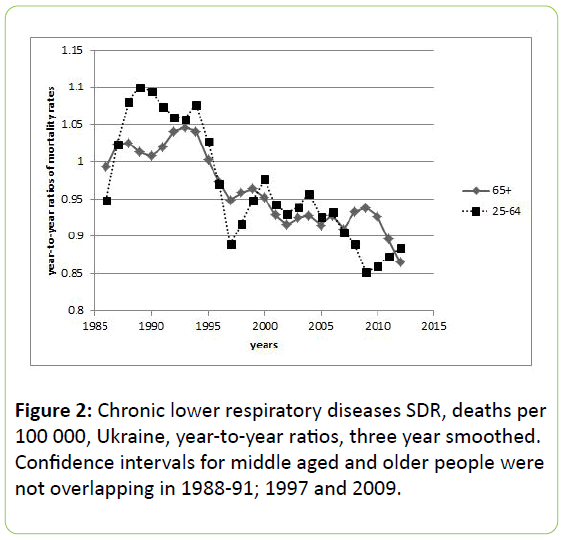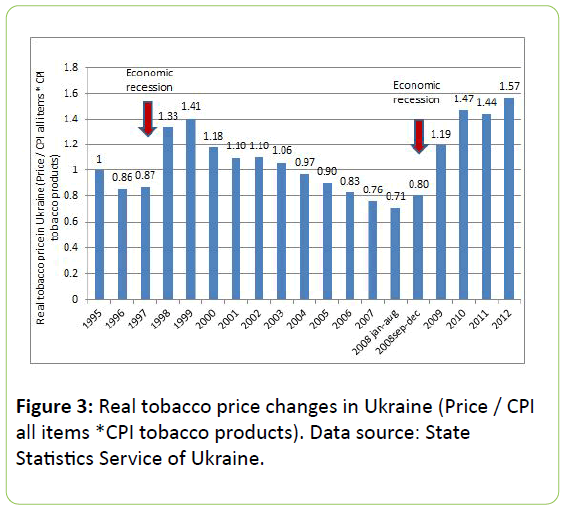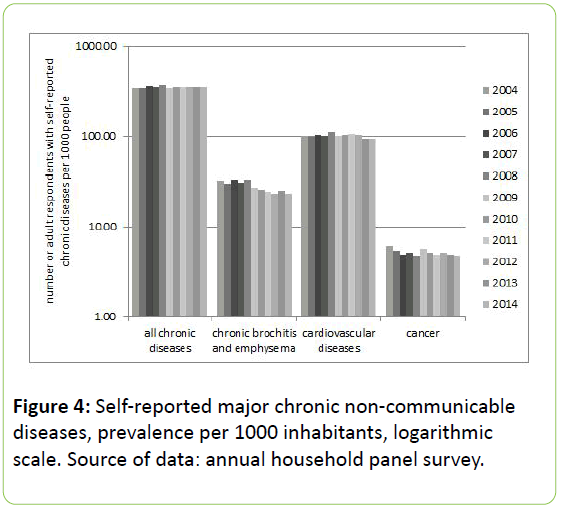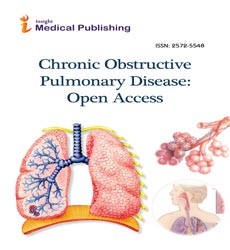COPD Morbidity and Mortality in Ukraine after Tobacco Control Policies Implementation
Tatiana I Andreeva and Konstantin S Krasovsky
DOI10.21767/2572-5548.100003
Tatiana I Andreeva1* and Konstantin S Krasovsky2
1School of Public Health, National University of Kyiv-Mohyla Academy, Kiev, Ukraine
2Head of Tobacco Control Unit,Ukrainian Institute for strategic Research of the Ministry of Health of Ukraine, Kiev, Ukraine
- *Corresponding Author:
- Andreeva TI
School of Public Health, National University of Kyiv-Mohyla Academy
Kiev, Ukraine
E-mail: tatianandreeva@gmail.com
Received Date: December 23, 2015 Accepted Date: January 04, 2016 Published Date: January 13, 2016
Citation: Andreeva TI, Krasovsky KS (2016) COPD Morbidity and Mortality in Ukraine after Tobacco Control Policies Implementation. Chron Obstruct Pulmon Dis 1:3. doi: 10.21767/2572-5548.100003
Copyright: © 2016 Andreeva TI, et al. This is an open-access article distributed under the terms of the Creative Commons Attribution License, which permits unrestricted use, distribution, and reproduction in any medium, provided the original author and source are credited.
Abstract
Tobacco is a known cause of COPD and smoking cessation is known reduce the risk of developing COPD. Whether tobacco control policies resulting in decreased prevalence of smoking are followed by short-term changes of morbidity and mortality indicators is unknown. We explored how recent successes in tobacco control in Ukraine are reflected in routinely collected data related to COPD.
Methods: We used publicly available sources of information: European Mortality database for standardized death rates and aggregated results from panel household surveys with questions on any and respiratory chronic diseases for morbidity.
Results: In early 1980s, chronic pulmonary mortality in Ukraine was 25-30 deaths/100 000, it increased to almost 60/100 000 in 1995 and then was steadily declining to 18/100 000 in 2010s. The upward mortality trend in 1987-95 was more expressed in middle-aged people compared with older ones. The declining mortality trend after 1995 was accelerating over time, was similar among men and women and much faster in middle-aged people than in older ones. The accelerated decline of respiratory mortality was observed during the economic recession of late 1990-s and in years of increased cigarette real prices. The dynamics of self-reported major chronic non-communicable diseases reveals the decline in chronic bronchitis and emphysema from 33/1000 in 2008 to 23/1000 in 2012, while no changes were observed in all chronic, cardiovascular diseases and cancer.
Conclusion: Major changes in COPD mortality in 1980-2010 were concurrent with changing economic conditions and could only partially be tobacco-related. Tobacco control policies, conducted in Ukraine since 2005 could accelerate then happening COPD mortality decline. In the time of both mortality increase and decrease, middle-aged people reacted faster than those older ones, probably due to greater role of behavioral factors in younger people. COPD morbidity started to decrease only since 2009 when cigarettes became much less affordable.
Keywords
COPD; Morbidity; Mortality; Tobacco control policies; Economic recession
Introduction
Chronic obstructive pulmonary disease (COPD) is responsible for early mortality, high death rates and significant cost to health systems. The projection for 2020 indicates that COPD will be the third leading cause of death worldwide (from sixth in 1990) and fifth leading cause of years lost through early mortality or handicap (disability-adjusted life years) (12th in 1990) [1]. According to the World Health Organization [2], more than 3 million people died of COPD in 2012, which is equal to 6% of all deaths globally that year. While the wellknown risk factors of COPD include air pollution, infections and occupational factors, the primary cause of COPD is tobacco smoke (through tobacco use or second-hand smoke) [2].
Whether recent successes in tobacco control policies undertaken in many countries within the process of Framework Convention on Tobacco Control (FCTC) [3] have already resulted in COPD morbidity and mortality decline is a subject of debate. A further increase of morbidity and mortality due to COPD is still forecasted, especially in women, taking into account increasing life expectancy and the change of smoking habits of the population [4]. In the analysis of mortality dynamics in the USA between 1969 and 2013, it was found that while most major causes of death were declining, this was not the case for the COPD [5]. In another analysis of the United States data, it was shown that the increasing trends of COPD prevalence, morbidity, and mortality seen in the later part of last century have not continued in the first decade of the 21st century. This is considered a function of the overall decreasing prevalence of tobacco use over the past 50 years, along with improved therapies for COPD [6]. Data from other countries conclude that COPD prevalence among adult population is high [4,7,8] but being predominantly crosssectional do not contribute much in answering the above research question.
While it is clear that after decreased uptake of smoking among young people we can expect lower COPD morbidity and mortality in a longer-term perspective, the evidence base for the benefits of quitting smoking as related to the morbidity and mortality outcomes in patients with existing COPD is limited [9]. Thus it is unclear whether tobacco control policies resulting in decreased prevalence of smoking can get reflected in short-term changes of morbidity and mortality indicators. Taking these uncertainties into account we aimed to explore whether recent successes in tobacco control in Ukraine are reflected in routinely collected data related to COPD.
Ukraine is characterized with extremely high COPD mortality rates compared with other European countries: while number of deaths per 100 000 of population is below 20 in Greece, Sweden, Iceland and Norway, it is more than 80 in Ukraine [1]. Despite high mortality rates, very limited epidemiological COPD data are available in Ukraine [10]. According to the WHO estimates [11], 58% of COPD deaths in Ukraine were tobaccorelated, while worldwide 42% of all COPD were attributable to tobacco use in 2004.
After Ukraine adopted first tobacco control law in 2005 and ratified the FCTC in 2006, most of the FCTC recommended measures were enacted including two changes of tobacco packs health warnings in 2007 and 2011, several restrictions of smoking in public places and of tobacco advertising, and several substantial increases of tobacco taxes undertaken in 2008-2010. As a result of these policies, the prevalence of daily smoking in adult population declined from 36% in 2005 to 25% in 2010 [12] and continued to decline further at differing yearly pace [13].Because there might exist differing scenarios with regard to disease development and survival between men and women [14] as well as disparities related to age and socio-economic status (SES) [15], we tried, where possible, to consider existing data by these variables.
Methods
We used publicly available sources of information regarding Ukrainian population health based on the routinely collected data. For mortality data, we used standardized death rates (SDR) per 100 000 inhabitants, Chronic lower respiratory diseases [16]. SDRs were compared by year in age and gender groups, both within Ukraine and with other countries of Eastern Europe and the European Union, within shorter and longer time spans. To zero in the trends of mortality change in particular time spans, we considered the yearly changes of SDR as the ratio of year-to-year SDR, three-year smoothing was then done to diminish rate fluctuations. To estimate the significance of difference in trends of mortality between people of different age groups, we calculated confidence intervals for proportion ratios as recommended by Burt Gerstman [17].
As a proxy for morbidity, we used aggregated results from panel household surveys annually conducted by the Statistics Service of Ukraine available for 2004-2014 [18]. Among other questions, participants were asked whether they suffer from any chronic diseases and if the answer was affirmative, they were invited to specify the diseases they suffer from. The Statistics Service annual reports contain the estimated numbers of Ukrainian dwellers, who suffer from any chronic diseases and some particular groups of diseases, including chronic respiratory diseases (specified in the survey as 'chronic bronchitis or emphysema'). We then recalculated these as prevalence rates per 1000 of the population. To estimate economic situation in the country and relative cigarette prices, consumer price indexes for tobacco products and all goods were taken from the home page of the State Statistics Service of Ukraine, and data for gross domestic product (GDP) from the World Bank web-page.
Results
Mortality
While there is a clear decline in most indicators of COPD mortality in Ukraine since any tobacco control measures have been undertaken, a look at a wider time span (Figure 1) shows that this decline started much earlier. As seen from the WHO Europe Mortality Database [16], chronic lower respiratory diseases SDR was in early 1980-s at the level of 25-30 deaths per 100 000 inhabitants, close to the average rate for old countries of the EU. Further on, it rapidly increased in Ukraine up to almost 60 deaths per 100 000 in 1995, after that the mortality was steadily declining and again reached the levels documented in the EU at about 18 per 100 000 in early 2010-s. Moreover, the described respiratory mortality trend was typical not only for Ukraine; similar dynamics of COPD mortality can be seen for some of the neighboring countries. In Russian Federation (Figure 1), COPD mortality similarly increased, though to a lower peak than in Ukraine, till at least 1994 and similarly declined since 2000 with COPD mortality rates being close to those in EU countries in early 1980-s and since 2010.
Because this long-term mortality decline cannot be accounted for by tobacco control policies undertaken since 2005, we looked at whether the pace of mortality decline changed over time and could reflect the successes of tobacco control policies. The dynamic of smoothed year-to-year ratios of chronic lower respiratory diseases SDR shown in Figure 2 reveals that the mortality declined faster after active tobacco control measures have been launched, especially in years of high increases of cigarette real prices (Figure 3).
Besides that, differences are seen in how mortality changed among people of different age groups. The upward mortality trend in 1987-95 was more expressed in middle-aged people (25-64 years old) compared with older ones (65 years and older) with these differences between the year-to-year ratios being statistically significant in 1989-90. The declining mortality trend after 1995 was accelerating over time. The mortality decline in younger and older age groups was similar in some years, namely between 2000 and 2007; however, in late 1990 and in 2008-2011, chronic respiratory mortality declined in middle-aged people much faster than in older ones with confidence intervals for proportion ratios not overlapping in 1997 and 2009. This was seen similarly among men and women separately (data not shown). The latter of these two spans (2008-2011) of accelerated decline of respiratory mortality is observed in years after tobacco control policies started to be implemented. An earlier accelerated mortality decline of late 1990-s coincides with the time when Ukraine experienced regional economic recession. The decline in chronic lower respiratory diseases mortality in 1998 (Figure 1) is seen in Ukraine and is even greater in Russian Federation.
Morbidity
Overall prevalence of chronic diseases estimated from annual household panel surveys conducted in 2004-14 was rather stable on the level of 340-350 per 1000 inhabitants (Figure 4).
The dynamics of self-reported major chronic noncommunicable diseases reveals the decline in self-reported chronic bronchitis and emphysema from 33/1000 in 2008 to 23/1000 in 2012, or by 29%, while in 2004-2008 this rate was rather stable at 30-33/1000. In the same time span, selfreported cardiovascular morbidity was stable at the level of 102/1000 in 2004 to 103 in 2012 and self-reported cancer prevalence also remained stable on the level of 5/1000 respondents.
Discussion
Our analysis of routinely collected data on COPD-related morbidity and mortality in years that coincide and follow the implementation of tobacco control policies reveals that in Ukraine a substantial reduction in self-reported morbidity was documented as well as the accelerated reduction of chronic pulmonary mortality, especially in middle-aged people.
Despite obvious limitations of this exploratory enquiry based on the secondary analysis of routinely collected data, it suggests several questions that could be considered in further research. While both morbidity and mortality indicators show favorable trends since 2008, the question is what causal factors were at play.
Smoking cessation is the only evidence-based intervention that reduces the risk of developing COPD and slows down the accelerated decline in lung function in patients with COPD [19]. However, complete estimation of the effect of smoking cessation per se in patients with severe COPD is still difficult due to the limited data and methodological challenges. Several large observational studies with long follow-up suggest that smoking cessation decreases the risk (relative to continued smoking) of incident COPD and hospital admission with a COPD exacerbation [9]. The risk reduction of COPD exacerbations varies with duration of time since quitting smoking and cumulative tobacco exposure (pack-years of smoking) [20]. According to a study conducted in Denmark, self-reported smoking cessation was associated with a reduction in the risk of COPD morbidity of approximately 40% [21].
The tobacco control policies were first introduced in Ukraine in late 2005 starting with partial smoke-free policies, awareness activities including new health warnings on tobacco packs. These measures might have an impact on the prevalence and intensity of smoking and possibly on health consequences of those. However, further on, the tobacco control policies happened to coexist with the global economic recession in 2008-2011 which facilitated the adoption of higher tobacco excise taxes starting from 2008 [22]. Because similar or even greater decline in respiratory mortality was seen in late 1998 when no tobacco control measures were in place but the economic crisis was present, we assume that the economic hurdles and decreased affordability of purchases could be an alternative cause of the observed changes. Both in 1998 and 2009, real (inflation-adjusted) tobacco prices greatly increased in Ukraine (Figure 4). Along with this, in 2005-2009, smoking prevalence fell down in Ukraine to constitute 25% in 2009 [12], while in the EU it was 29% [23]. This could contribute to the fact that in 2012 COPD mortality in Ukraine was 15 per 100 000, which is lower than in the EU countries (Figure 1).
The analyzed data also show that Ukraine experienced substantial increase in COPD mortality in 1990-1995. At that time, the whole economy of the country was in crisis, including the tobacco industry; by 1993, cigarette production declined by half [24], so the COPD increase was not tobacco-related. In early 1990s, similarly to Ukraine, most countries of the former Soviet Union experienced poor economic growth and large increases in mortality. Between 1989 and 1994, male life expectancy at birth fell by over six years in Russia and by five years in Ukraine. Many other countries of the former Soviet Union saw similar declines, and female life expectancy shortened as well. The two factors that do appear to be important are alcohol consumption, especially as it relates to external causes of death (homicide, suicide, and accidents) and stress associated with a poor outlook for the future [25]. However, a large residual remains to be explained. The transition from communism led to a significant devaluation of human capital. Mortality appears to be associated with the prospect of suffering a substantial reduction in income, and hence living standards.
While smoking remains the single most important cause of pulmonary obstruction, in low-income countries other factors associated with poverty dominate among the risk factors of mortality due to COPD [26]. Probably very severe economic recession of early 1990s in Ukraine and other former USSR countries enhanced the impact of poverty-related COPD factors.
However, the overall mortality changes observed during the economic cycles can take the opposite directions depending on the country's economic situation. In poor countries, the economic growth appears to improve health by providing the means to meet essential needs such as food, clean water and shelter, as well access to basic health care services. But after a country reaches $5000 to $10 000 gross national product (GNP) per capita, few health benefits arise from further economic growth: in rich countries, mortality declines faster during recessions than during periods of economic growth [27]. In 1990-1995, GDP per capita in constant local currency [28] declined in Ukraine every year with average annual rate of decline 13%. Later, the situation improved and in 2000-2008 Ukraine experienced the economic growth with 8%average annual rate of increase. Only in 2009, the GDP decreased by 14.4% and then started to increase again.
In years of very severe and long crisis of early 1990s, which turned large number of people into poverty with little perspectives, the COPD mortality rates increased. Conversely, during less severe and shorter recessions, when people have just to cut some expenses, and smokers have less money to buy cigarettes, this leads to fewer exacerbations of their disease and lower risk of death.
A person with COPD can die due to many other immediate causes of deaths. Some of them are alcohol-related. In Russia, COPD mortality was found to be significantly associated with heavy alcohol consumption [29]. In Ukraine, a substantial part of the mortality decline during the recession in 2009-2010 was alcohol-related [30]. However, the death certificate might contain a chronic disease--COPD in this case--while the death in fact was caused by alcohol intoxication or similar. If alcohol becomes less affordable, these people less likely die, so COPD less likely gets in the mortality statistics. Other theories of indirect and competing impact of economic limitations on COPD-related mortality can be true as well. Studies on mortality due to COPD or other respiratory causes can all be subject to the biases, such as so-called reverse causality (illquitter or healthy smoker effect) and underreporting or misclassification of COPD on death certificates is likely to influence the associations between smoking cessation and mortality [9].
Additionally to routine data use, other limitations of our study include the insufficiency of the data for more thorough consideration by those socio-demographic groups where certain effect measure modification might be present. The only discrepancy that was clearly seen was that between younger and older population groups with middle-aged people reacting quicker to the changing life conditions with both increase and decrease of respiratory mortality. While we could expect from the literature that the trends for women would be lagging behind those among men [14], this has not been revealed for Ukraine, which could be accounted for by less advanced tobacco epidemic among women and its relatively fast round up after effective tobacco control measures have been undertaken [12].
Conclusion
We used the analysis of routinely collected data to explore whether tobacco control policies are reflected in the shortterm changes of COPD morbidity and mortality indicators. Considering the case of Ukraine, we observed several periods of major changes in COPD mortality. In 1980-1995, the COPD mortality greatly increased in Ukraine which could be due to the deteriorating economic conditions. When the economic situation improved, COPD mortality started decreasing. Tobacco control policies, conducted in Ukraine since 2005, contributed to the COPD mortality decline. In the time of both mortality increase and decrease, middle-aged people reacted faster than those older ones, which is probably related to greater contribution of behavioral factors in younger people. COPD morbidity started to decrease only since 2009 when cigarettes became much less affordable in Ukraine.
References
- Raherison C, Girodet PO (2009) Epidemiology of COPD. Eur Respir Rev 18: 213-221.
- World Health Organization (2015) Chronic obstructive pulmonary disease (COPD), Fact sheet N°315, updated January 2015.
- World Health Organization (2005) WHO Framework convention on tobacco control, Geneva: World Health Organization.
- Geldmacher H., (2008) [The prevalence of chronic obstructive pulmonary disease (COPD) in Germany. Results of the BOLD study]. Dtsch Med Wochenschr 133: 2609-2614.
- Ma J (2015) Temporal Trends in Mortality in the United States, 1969-2013. Jama 314: 1731-1739.
- Rosenberg SR, Kalhan R, Mannino DM (2015) Epidemiology of Chronic Obstructive Pulmonary Disease: Prevalence, Morbidity, Mortality, and Risk Factors. in Seminars in respiratory and critical care medicine.
- Buist AS, Vollmer WM, M.A. McBurnie (2008) Worldwide burden of COPD in high- and low-income countries. Part I. The burden of obstructive lung disease (BOLD) initiative. Int J Tuberc Lung Dis 12: 703-708.
- Nizankowska-Mogilnicka E (2007) Prevalence of COPD and tobacco smoking in Malopolska region--results from the BOLD study in Poland. Pol Arch Med Wewn 117: 402-410.
- Godtfredsen NS (2008) COPD-related morbidity and mortality after smoking cessation: status of the evidence. Eur Respir J 32: 844-853.
- Tolubaie V (2015) COPD in Ukraine: overview of the status and prospects for improvements and developments in health care system. Journal of Health Policy & Outcomes Research 66-75.
- World Health Organization (2012) WHO global report: mortality attributable to tobacco, Geneva: World Health Organization.
- Ministry of Health of Ukraine (2010) Ukraine Global Adult Tobacco Survey country report ed. T. Andreeva, et al., Kiev: Ministry of Health of Ukraine..
- Krasovsky K (2014) Tobacco Control in Ukraine. Second National Report.–Kyiv: Ministry of Health of Ukraine 128.
- Mannino DM (2006) Women and chronic obstructive pulmonary disease: does sex influence survival? Am J Respir Crit Care Med 174: 488-489.
- Au DH, Feemster LC (2014) Chronic Obstructive Pulmonary Disease. Health Disparity and Inequity. Annals of the American Thoracic Society 11: 1250-1251.
- World Health Organization Regional Office for Europe, European mortality database (MDB), 2015.
- Gerstman BB (2003) Epidemiology kept simple: an introduction to traditional and modern epidemiology: Wiley-Liss 417.
- State Statistics Service of Ukraine. Income and Living Conditions, 2015.
- Anthonisen NR (2000) Smoking, lung function, and mortality. Thorax 55: 729-730.
- Au DH (2009) The effects of smoking cessation on the risk of chronic obstructive pulmonary disease exacerbations. J Gen Intern Med 24: 457-463.
- Godtfredsen NS (2002) Risk of hospital admission for COPD following smoking cessation and reduction: a Danish population study. Thorax 57: 967-972.
- Krasovsky K (2013) Sharp changes in tobacco products affordability and the dynamics of smoking prevalence in various social and income groups in Ukraine in 2008-2012. Tob Induc Dis 11: 21.
- Eurobarometer (2010) Tobacco Special Eurobarometer 332.
- Krasovsky K (2002) The Economics of tobacco control in Ukraine from the public health perspective, Kiev 128.
- Brainerd E, Cutler DM (2004) Autopsy on an empire: understanding mortality in Russia and the former Soviet Union, National Bureau of Economic Research.
- Burney P (2014) Chronic obstructive pulmonary disease mortality and prevalence: the associations with smoking and poverty--a BOLD analysis. Thorax 69: 465-473.
- Bezruchka S (2009) The effect of economic recession on population health. Cmaj 181: 281-285.
- The World Bank (2015) GDP per capita growth (annual %).
- Zaridze D (2009) Alcohol and cause-specific mortality in Russia: a retrospective case-control study of 48,557 adult deaths. Lancet 373: 2201-2214.
- Polishchuk M, Krasovsky K, Andreeva T (2009) Changes of average life expectancy in Ukraine for last 50 years as a parameter of efficiency of public health care (in Ukrainina). Ukraine. Health of the nation 4: 54-61.
Open Access Journals
- Aquaculture & Veterinary Science
- Chemistry & Chemical Sciences
- Clinical Sciences
- Engineering
- General Science
- Genetics & Molecular Biology
- Health Care & Nursing
- Immunology & Microbiology
- Materials Science
- Mathematics & Physics
- Medical Sciences
- Neurology & Psychiatry
- Oncology & Cancer Science
- Pharmaceutical Sciences
